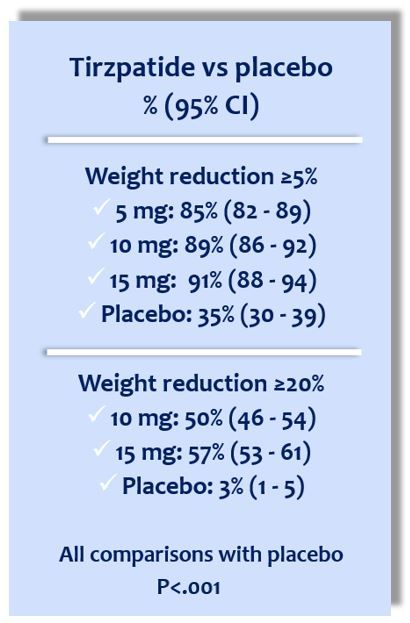Tirzepatide Treatment Leads to Weight Loss of up to 22.5% in SURMOUNT-1 Clinical Trial
ADA 2022: Tirzepatide led overall to weight loss of up to 22.5% of baseline body weight with persons taking the 15 mg dose losing an average of 52 pounds.
©Slam/adobe stock

Individuals with overweight or obesity taking tirzepatide lost up to 22.5% of their baseline body weight, according to findings from the SURMOUNT-1 trial, presented at the 82nd Scientific Sessions of the American Diabetes Association (ADA) in New Orleans, LA. The results were published simultaneosly in the New England Journal of Medicine.
SURMOUNT-1 is the first investigational phase 3 trial evaluating the safety and efficacy of the novel once-weekly GIP (glucose-dependent insulinotropic polypeptide) and GLP-1 (glucagon-like peptide-1) receptor agonist for the treatment of obesity.
“These results are an important step forward in potentially expanding effective therapeutic options for people with obesity. Notably, about 9 out of 10 individuals with obesity lost weight while taking tirzepatide,” said Ania Jastreboff, MD, PhD, associate professor Yale University School of Medicine, director of Weight Management and Obesity Prevention at the Yale Stress Center and co-director of the Yale Center for Weight Management, New Haven, Connecticut, in an ADA press statement.
Inclusion criteria for SURMOUNT-1 were age ≥18 years, body mass Index (BMI) ≥30 kg/m², or BMI ≥27 kg/m² with at least one weight-related comorbidity (eg, hypertension, dyslipidemia, obstructive sleep apnea, cardiovascular disease) and a history of at least one unsuccessful effort to lose weight with dietary measures. Exclusion criteria included a diagnosis of diabetes, weight change >5 kg within 3 months of start of study, and obesity induced by other endocrinologic disorders.
Investigators identified the coprimary endpoints as percent change in body weight from baseline to week 72 and percentage of participants achieving body weight reductions of at least 5% compared to placebo. Among the secondary endpoints of interest were absolute change in body weight from baseline, percentage of participants who achieve weight reduction of ≥10%, ≥15%, and ≥20%, and change in waist circumference and BMI.
In total, 2539 participants with obesity or overweight met the SURMOUNT-1 inclusion criteria and were included in the final analyses. Individuals were assigned in a 1:1:1:1 ratio to receive once-weekly, subcutaneous tirzepatide (5 mg, 10 mg, or 15 mg) or placebo for 72 weeks, including a 20-week dose-escalation period.
SURMOUNT-1 findings

Overall, SURMOUNT-1 participants who received terzepatide lost between 16% and 22.5% of their baseline body weight.
The mean percentage change in weight at week 72 for the 3 tirzepatide doses was (% / 95% CI):
- 5 mg: −15.0% (−15.9 to −14.2)
- 10 mg: −19.5% (−20.4 to −18.5)
- 15 mg: −20.9% (−21.8 to −19.9)
- Placebo: −3.1% (−4.3 to −1.9)
All comparisons with placebo for change in weight were statistically significnant (P<.001). Percentage of participants meeting the coprimary end point of weight reduction ≥5% are shown at right.
For participants who received tirzepatide 15 mg, the highest dose, the average amount of weight lost was approximately 52 pounds.
Weight loss on the 2 lower doses of tirzepatide also was substantial: 35 pounds for the 5 mg dose and 49 pounds for the 10 mg dose.
In terms of safety and tolerability, the tirzepatide profile was similar to other incretin-based therapies approved for the treatment of obesity. The most commonly reported adverse events were gastrointestinal in nature, mild to moderate in severity, and most often occurred during the early dose-escalation phase.
“Obesity should be treated like any other chronic disease—with effective and safe approaches that target underlying disease mechanisms, and these results underscore that tirzepatide may be doing just that,” said Jastreboff in the ADA statement.
Writing in NEJM the authors note that when compared to the average weight reduction seen with placebo-treated participants, the average of 19.5% and 20.9% with the 10- and 15-mg doses of tirzepatide, respectively, "is an unusually substantial degree of weight reduction in response to an antiobesity medication" when compared to other phase 3 findings with antiobesity medications. They suggest that there may be an additive benefit in the dual incretin mimetic approach that targets multiple endogenous meal-stimulated hormone pathways implicated in energy homeostasis.
Tirzepatide was approved in May 2022 by the U.S. Food & Drug Administration as an adjunct to diet and exercise to improve glycemic control in adults with type 2 diabetes.
Reference: Jastreboff AM, Aronne LJ, Ahmad NN, et al, for the SURMOUNT-1 Investigators. Tirzepatide once weekly for the treatment of obesity. N Engl J Med. Published online June 4, 2022. doi: 10.1056/NEJMoa2206038